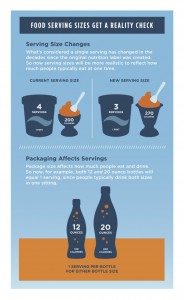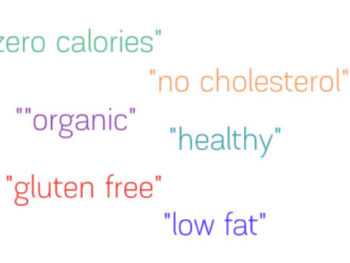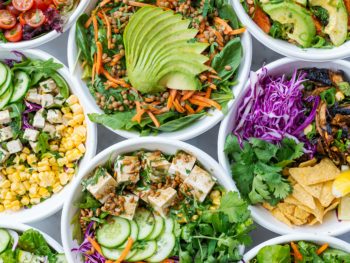Below is my blog post for Huffington Post, “New food labels reflect how much we really eat.”
You can also read it HERE.
First Lady Michelle Obama and the Food and Drug Administration (FDA) recently announced sweeping changes to the Nutrition Facts labels. According to the FDA, the new food label required on packaged foods will reflect the newest scientific information including the relationship between diet and obesity.
This is the first overhaul in over 20 years and most companies will have until July 2018 to revise their food labels. Some of the changes will help consumers become more aware of how much they are eating along with how many calories and added sugar are in their favorite foods. The hope to help us make healthier—and more informed—food choices.
As a nutritionist and portion size researcher, I applaud the changes.
Here are some of the changes you can expect to see.
1. Serving sizes will reflect how much we really eat.
As I wrote in my book The Portion Teller Plan and research articles, we are eating more—often lots more—than we were 20 years ago. Many of our portion sizes are two to five times larger than they were in the past. The serving sizes on the food label will now be reflecting the increase.
So you will see that the serving size for many foods typically consumed will be bigger. According to FDA, nearly 20% of the serving sizes will change to reflect more typical consumption. For example, the serving size for ice cream will increase from 1/2 cup to 2/3 cup; a serving of soda will increase from 8 oz. to 12 oz.; and your favorite bagel or muffin serving will increase from 2 oz. to 4 oz. After all, who eats just a half a muffin at a sitting? Too bad—but the yogurt serving size will decrease from 8 oz. to 6 oz. (Indeed, we are eating more of the unhealthy stuff!)
It is important to realize that the calorie and nutrient information will also be changing to reflect the new serving size.
According to FDA, “By law, serving sizes must be based on amounts of foods and beverages that people are actually eating, not what they should be eating.” The new serving sizes will be a reality check for how much we actually eat and may hopefully encourage us to eat less.
I recently reported on research that found that larger serving sizes on food labels will encourage us to eat less and may actually help fight the obesity epidemic. However, it is important that we do not view larger serving sizes for some (unhealthy) foods as a recommendation to eat more. Indeed, that is not FDA’s intention. While you may love ice cream, the feds are not suggesting that we eat more.
To avoid the unintended consequences of more typical serving sizes, I would have liked to see a footnote on the label to clarify that “the serving size is based upon the amount typically consumed, and is not a recommended portion size.” Let’s hope FDA follows up with an education campaign.
2. Calories, serving size, and number of serving per container will be in large font and easy to read.
Great news if you are among those who actually read the food labels. You will now be able to see how many calories are in your favorite foods along with the number of servings per container without needed a magnifying glass. This is so important especially since so many people do not pay any attention to the number of servings per container. Hopefully, now they will.
3. Your 20 oz. soda bottle will now be considered a single serving.
One of my biggest pet peeves from spending a life time counseling clients trying to lose weight was the food labels on packages usually consumed as a single serving—the 20 oz. soda bottle and the small bag of popcorn. A 20 oz. soda bottle, for example, was allowed to be labeled with 2.5 servings even though most people were not going to share it. Same for the small bag of popcorn or single muffin that was labeled 2 servings per package. Finally, this is about to change.
For packages that are between one and two servings, and typically consumed in one sitting, such as a 20 oz. soda, the food label serving size will be 20 oz. and the calories and nutrients will reflect that size. Previously, the serving size was 8 oz. (which contains 100 calories). While most people would drink the entire bottle, and guzzle down 250 calories, they may actually think they were just drinking 100 calories.
This is a big step forward for disclosure and may help people get a better understanding of how many calories they are eating.
4. If you polish off a pint of ice cream, you can see how many calories you just consumed.
A pint of ice cream along with a 3 oz. bag of chips and a 24 oz. soda bottle will now contain a dual column. Manufacturers will have to provide “dual column” labels to indicate the amount of calories and nutrients on both a “per serving” and “per package” basis for food products that are bigger than a single serving but could be consumed either in one sitting or in multiple sittings. This rule would apply for packages that contain 200% and up to and including 300% of the standard serving size.
The purpose of the dual columns is for consumers to see how many calories—and nutrients—they will get if they eat an entire package (which many of us often do.)
5. You will see how much added sugar is in your favorite foods and drinks.
For the first time, under new FDA label rules, food and beverage companies will be required to disclose added sugars on the Nutrition Facts label. FDA is requiring food labels to display grams along with a % Daily Value (DV) for added sugars. The DV for added sugar—to consume no more than 10% of calories from added sugar—is consistent with the recent recommendations set forth in the 2015-2020 Dietary Guidelines.
This is great progress and I applaud the FDA for requiring food packages to list added sugars. Too much sugar is linked to obesity and chronic disease. The new food labels will hopefully help consumers to see just how much sugar is in their favorite foods.




